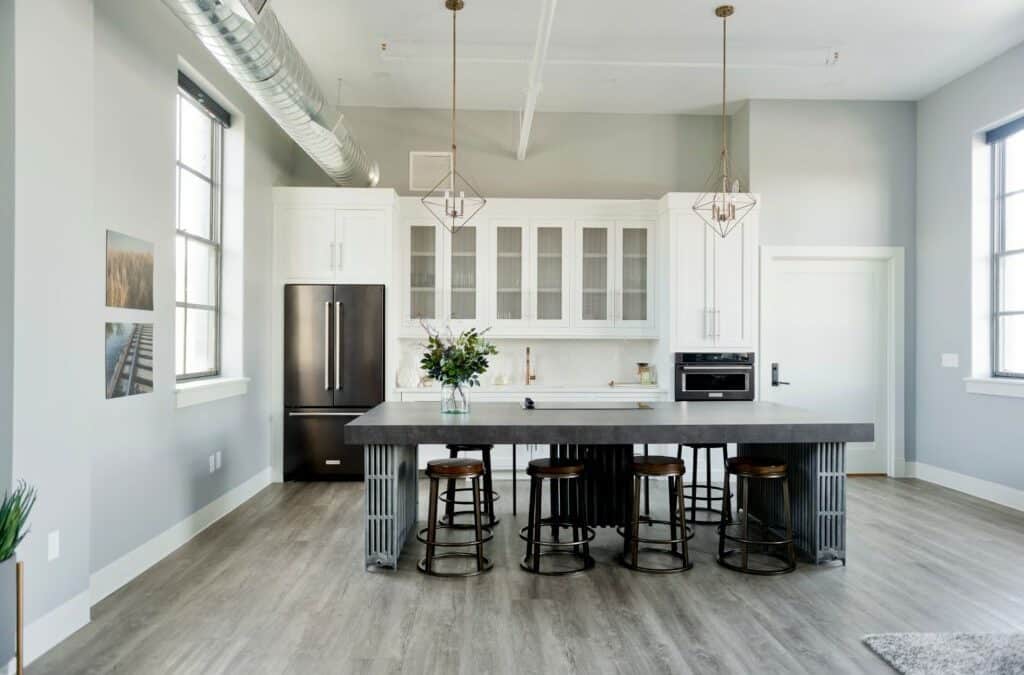designKitchens are not one-size-fits-all and everyone has individuals needs. So how do you create an accessible kitchen that suits your needs and is just as beautiful as it is practical?
- Safety
You may not know it, but kitchens are regarded as the most dangerous room in your home, with accidents more likely to occur there than anywhere else.
With the risk of slips, burns and cuts, kitchens pose a number of risks to its users.
These risks are even more serious when the kitchen design itself has not been made with accessibility in mind.
If you are disabled or part of a multi-generational household, you may find that the standard kitchen does not cater to everyone’s needs, which is why accessible kitchen design is so important.
When designing an accessible kitchen, the essential point to consider is of course the safety of the user while they’re in it.
Safety in your kitchen may feel like a given, but design and features are easily overlooked when it comes to creating an accessible space. These flaws can pose a serious risk to wheelchair users or those with disabilities.
What looks good does not always equal what is safe and functional, which is why it’s best to consult with your kitchen supplier about your specific needs to ensure your kitchen works for you.
Even simple changes such as opting for handles that are curved as opposed to ones with sharp edges can reduce the chances of injury. The depth of handles can also be adjusted so there is more space for a comfortable grip.
There are so many ways to tailor a kitchen to you, you can create your own safe space without compromising on the aesthetic.
2. Lower kitchen worktops
One easy way to make your kitchen design accessible for wheelchair users is to drop the height of your kitchen worktops and ensure there is adequate knee-space beneath countertops and tables. Whether you’d prefer to have all worktops lowered for ease of use or if you’d prefer a variation in heights, it’s a great way to adapt an existing kitchen if you’re not looking to start from scratch.
The average height of worktops in the UK is 90 cm which is too high for the majority of standard wheelchairs, and therefore not accessible. To combat this, adjustable worktops have seen a rise in popularity for those that live in multi-generation and/or multi-ability households. Adjustable worktops can be pulled up or down to suit the needs of the user.
Playing with the different levels of your kitchen can work really well from a interior design perspective, making your kitchen look bigger and lighter as you create a multi-dimensional space.
3. Open-plan layout
Creating a kitchen that is comfortable to move around in is key for creating an accessible kitchen, after all, you’re going to be spending a lot of time in it.
We’ve made guides to the pros and cons of well-known kitchen design layouts so if you’re unsure which will work for you we suggest you start there!
For accessibility, we’d recommend designs without dead-ends or large islands that restrict the space and create narrow pathways.
4. Room to move
Cooking and entertaining can take up a lot of space, as we’ve discussed in previous kitchen design blogs there is a danger of creating a ‘bottle-neck’ of traffic in your kitchen. This is essentially when you get stuck in one area because you cannot get past another person in the kitchen.
Ensuring that your measurements are right for you, and the space between worktops and/or islands are wide enough for you to go through can be a simple check that saves you from a lot of frustration in the long-term.
5. Storage placements
The placement of storage options is key for all kitchens, and especially so if you need to keep surfaces and walkways clutter-free.
Ensuring that cupboards are reachable at multiple-levels is a simple yet effective way to make a kitchen accessible.
Choosing cupboards with doors that slide beneath or to the side gives you full accessibility without having to contort your body around an awkwardly placed door.
6. Smart Appliances
Having smart appliances are a must-have for accessible kitchens, and there are plenty of accessories and appliances to consider.
A number of modern kitchen appliances come with features such as control through bluetooth which can really help with ease of use.
Mid-height ovens are also a staple for many homes of wheelchair users.
Consider building amenities that can be stowed away nicely and are installed flush to whatever surface they are on. This helps when it comes to cleaning your kitchen and keeping appliances stored safely.
7. Low-maintenance materials
If you know you or someone in your household will struggle to clean any spillages right away, then the material you choose for your worktops is important.
Some of the most popular stone options for worktops, such as Marble worktops, are softer than others and are therefore prone to scratches, staining and other damage.
Other worktop materials such as Granite worktops or Quartz countertops are much more durable and are the perfect choice for anyone who would prefer not to have a strict care routine. Granite and Quartz can withstand high-traffic and look stunning even with some wear and tear.
We hope our blog has helped you plan for your an accessible kitchen design! If you’d like to learn more about kitchen design, quartz worktops, or even bathroom countertops, why not explore more of our blog posts?
